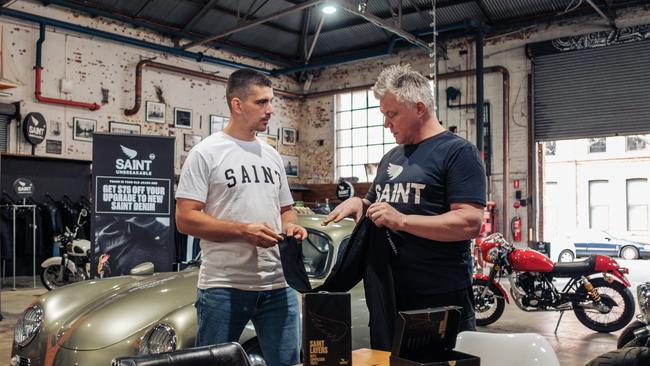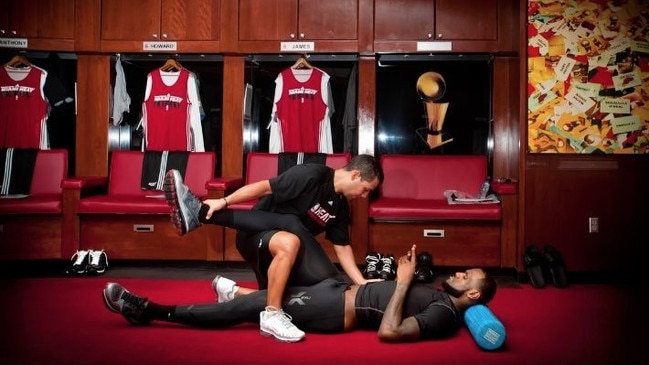Does compression wear make you go faster, higher and stronger?
A photo of LeBron James in 2XU tights shot Aidan Clarke’s Melbourne firm to a $1bn valuation. As he launches a new brand, we ask does compression wear make you faster?

Logan Roy, the fictional patriarch of the hit TV show Succession, met his demise because he didn’t wear his white medical grade compression socks, less he appeared unattractive to his younger lover while flying to Scandinavia.
As a result, a blood clot formed in his leg and made it all the way to his heart causing his death in what is known as a pulmonary embolism.
It acted as a cautionary tale, with another senior executive hastily putting on a pair of such socks in the next scene involving a plane – valuing their life rather than sex appeal.
In the real world, Melbourne-based entrepreneur Aidan Clarke, 51, doesn’t have such a problem. He has made a fortune from compression wear, and making the tight fitting garments look sexy and desirable.
His formula proved a success in 2012 when NBA superstar LeBron James was photographed, in a reclined position, wearing one of Clarke’s black compression tights, the telltale sign of which was the ‘X’ printed on the basketballer’s thigh.

It was a shot that sent the company, 2XU, that Clarke founded with Clyde Davenport and triathlete Jamie Hunt, hurtling towards a $1bn valuation.
But do slick compression sport wear products have the same health benefits as their dull medical-grade counterparts, particularly when it comes to boosting blood flow and reducing swelling in the quest to go faster, higher, stronger?
Clarke and his fellow 2XU founders later progressively sold the company – with John Wylie’s Tanarra Capital taking an early equity stake – and later private equity fund L Capital Asia, backed by LVMH, the French luxury giant that owns Christian Dior, Givenchy, Louis Vuitton and Moet Hennessy.
Big name backers for what has become a global market worth an estimated $US4.5bn, with its overall value expected to hit $US7.2bn by 2032, according to FACT.MR.
Compression tights, socks and sleeves in myriad brands can be seen in the dawn beachside exercise sessions from Manly to St Kilda, as athletes look to gain that extra per cent of a per cent of performance as well as stave off the dreaded delayed muscle soreness.
There now is a compression garment for nearly every type of sport activity, whether it is hitting the gym, marathon running or cross training.

But while the benefits of medical grade compression wear are well known – whether it is a doctor instructing you to wear a pair before surgery or a flight to prevent a Logan Roy-type blood clot – the evidence in sports garments is less conclusive.
As Clarke prepares to launch his new activewear brand – SA1NT Layers – next week with Davenport, he is well aware of the problem.
Sport giants, such as Nike and Adidas, have launched their own compression wear ranges, while home brand options can be found in the special buys bins at Aldi and Kmart. But Clarke says not all compression garments are created equal – even from the big brands.
“So many of the sports brands don‘t do me a favour because they use the word compression but don’t give enough pressure,” Clarke says.
“If you buy a really cheap compression product, it‘s probably not going to be delivering the power it really needs to actually maximise your blood return. You’re never going to squeeze the blood out of the capillaries back into the venous system and you’re not really going to get a benefit. After a month and you’ll find them like pyjamas, they just lose their power.
“That was what we‘re always up against with my old brand (2XU) and we will be a little bit with this brand too.”

Clarke has invested $3m of his own money to launch SA1NT Layers and is looking to raise several million more to build a “war chest” to create the company’s own LeBron moment.
“I‘m just making sure I’m geared up to take advantage of the opportunities. If somebody turns around and says ‘hey, we want to secure your amazing tight in our channel but we want $5m of product’ then you know I can go make it immediately. So that’s why I’ve capital raised, just to be ready to act on the opportunity to scale.”
Clarke has backed SA1NT – which initially started as a jeans and protective motorcycle clothing brand – for almost a decade. He is obsessive about fabrics and outsources manufacturing to a medical-grade hosiery company to ensure they live up to the benefits claimed.


Ahead of the launch, elite athletes, including the Melbourne Rebels and English and Welsh rugby teams have adopted SA1NT compression wear.
Clarke would have started the brand sooner but he was subject to a non-compete when he sold 2XU.
And he doesn’t feel any pressure of replicating the same level of success that he achieved at 2XU.
“To be frank it was a lot of unfinished business because we grew 2XU and it exploded and we kind of then trusted the process of handing over so many decisions to equity partners and second guessing yourself because you know when you build a $200m business on your way to becoming a $1b company … to some degree, we didn’t just stick to the formula of passion.
“And so the lesson for me is, I‘m going to stick to the formula of passion with this brand (SA1NT). I don’t need to sell it to make my initial money. I’m motivated by the fact that I love the industry and I love making great products, and I’d much rather see a succession here and have my son working in the business or my daughter working in the business.
“I kind of feel less pressure this time around because I‘m not a 30 year old trying to make a fortune. I know how to do that. The pressure comes from making sure that I make exceptional products. I want to be proud of every garment we make.”

Such was the degree of fabric obsession that SA1NT developed a denim for its jeans, woven with Dyneema – the same fibre that stops bullets, tethers space shuttles and armours helicopters – that can give motorcycle riders 75 metres of skid protection – sparking the company’s “unbreakable” slogan.
Whether you’re a weekend warrior or professional athlete, boosting recovery or performance becomes equally obsessive. Tanarra has backed a skincare start-up, Premax, after John Wylie felt the need to get his aching limbs treated to survive a marathon.
But what do physiotherapists say about sports compression wear and do they live up to the benefits claimed?
Rob Edwards, a physiotherapist at Amplar Health – a division of Medibank – says sports compression wear is typically of a lower grade compared to medical compression wear.

“Determining the effect compression has on performance in sport is challenging, there‘s no conclusive proof that compression enhances sporting accomplishments,” Edwards says.
“However, some research suggests that sports grade compression may improve performance, and many athletes report feeling a greater awareness of their body when wearing compression, due to the compression enhancing the body‘s sense of position (known as proprioception).
“There is also some evidence to support that wearing compression after activity enhances recovery by boosting venous return and reducing the duration and severity of delayed onset muscle soreness, or DOMS (the fatigue and muscle pain that usually starts twenty four hours post vigorous exercise).”
To this end, Edwards says “there are no downsides to wearing sporting grade compression, and anything that enables or facilitates people to participate in physical activity”.
“Be it because of fashion or research – (it) should be encouraged. At the end of the day, the more people are moving, and the more comfortable they are while doing so, the healthier they’ll be – and the more likely they’ll prevent a large range of health conditions.”





To join the conversation, please log in. Don't have an account? Register
Join the conversation, you are commenting as Logout